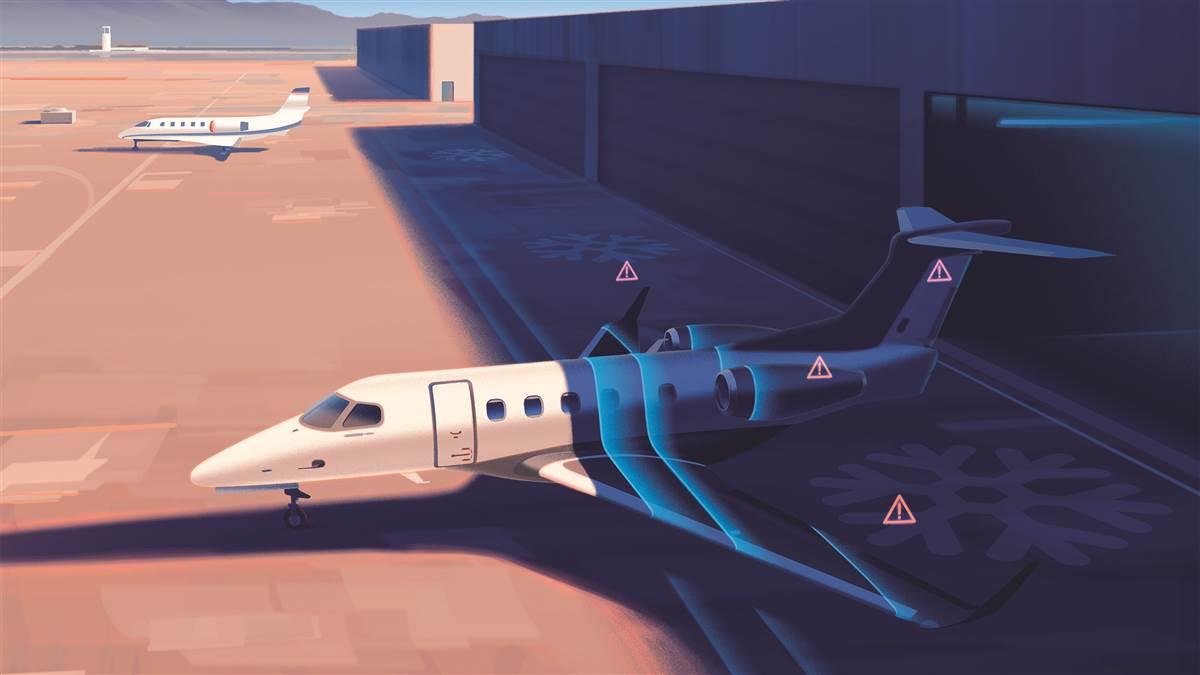Worth the wait
Clearing ice before takeoff isn’t optional

Shortly before 11 a.m. MST on January 2, 2023, an Embraer Phenom 300 was towed out of a heated hanger at the Provo Municipal Airport (PVU) in Utah to take three passengers on a Part 91 flight to Chino, California. The single pilot had completed his preflight inspection in the hangar, but the jet still needed fuel. As a lineman put in 350 gallons of Jet A, the pilot mentioned that “they were trying to get out before the weather.” The lineman noticed “what appeared to be unfrozen water droplets on the wings,” and light snow began falling as he drove his truck back to the FBO. An airport worker clearing the snow said that within a few minutes, it had covered the areas he’d plowed.
The ice protection system of the Phenom 300 uses engine bleed air to heat metal strips on the leading edges of the wings and horizontal stabilizer. Separate systems heat the windshields and air data systems (ADS) and provide engine anti-ice. The wing and stabilizer system is controlled by a three-position switch. A lamp on the left side of the fuselage enables the crew to check for ice formation on the left wing while flying at night.
The POH states unequivocally that “Airplane surfaces contaminated by ice, frozen precipitation or frost must be deiced before departure.” It goes on to distinguish between the use of “deicing” and “anti-icing” fluids. The latter continues to prevent ice build-up for a period called the “holdover time” and is required “when the risk of freezing precipitation exists at dispatch or freezing precipitation is actually taking place.” The structures needing protection include the fuselage, leading edges and upper surfaces of the wings and horizontal stabilizer, the upper surface of the elevator, and the vertical stabilizer and rudder—i.e., the entire upper side of the airplane.
Inspection for ice is “normally accomplished…within 5 minutes prior to beginning takeoff.” The crew can check the wings through the cabin windows, but “trained and qualified personnel outside the airplane” may be needed to check the tail and fuselage. Any indication of ice calls for repeating the de-/anti-icing application. The POH notes that these fluids “flow off the surface” during takeoff and thus do not provide any icing protection in flight.
The pilot asked the airport manager about deicing service and was told to call the FBO. However, its deicing truck was out of service. The manager advised him to check with a second FBO on the field, but while its truck was operational, staff there reported they were not contacted.
The Phenom was equipped with both cockpit voice recorder (CVR) and flight data recorder (FDR). The CVR recording began at 11:18:24 with the pilot telling a passenger how to enter the cabin. Right engine start was recorded at 11:20:47. Both engine anti-ice switches were turned on; four seconds later the left was turned off while the left engine was started, then reactivated. At 11:29 the wing/stabilizer anti-ice was turned on; the pilot commented “Yep, wing stab arm, we got that.” The system was then turned off and remained off through the end of the recording.
The pilot asked the airport manager about deicing service and was told to call the FBO. However, its deicing truck was out of service.
He confirmed operation of the ice sensor; then, at 11:34:28, he briefed the takeoff, saying that he’d “run up the engines with the brakes on and release them so we have less effect of that slush on the runway.” Both engine thrust levers were advanced, and the engine N1 speeds increased at 11:35:25; ground speed began to build seven seconds later. At 11:35:48, indicated airspeed reached the calculated V1 and VR of 103 knots. The pilot called out, “There’s V1 and rotate.”
The flight data recorder showed that as the weight-on-wheels indications went from “Gnd” to “Air,” the Phenom rolled left at an increasing rate. The stall warning activated at 11:35:53, just before the recording ended. The lineman who’d fueled the jet saw it taxi by and turned to watch the takeoff roll. A “light to medium intensity” of snow and misty rain were falling. The temperature and dew point were both recorded as being minus-1 degree Celsius. The lineman saw the airplane “pull up steep” and roll left until the left wing hit the ground. Other witnesses at the airport recalled seeing it climb to 20 to 30 feet before it wobbled back and forth, banked right, and then “banked hard left” into the runway.
Both wings separated from the airframe. The fuselage came to rest 597 feet beyond “a large impact crater,” with the wings travelling another 106 feet. The pilot was killed, and two of the three passengers suffered serious injuries; the third escaped with minor injuries. An NTSB performance study found that the jet reached a maximum angle of attack of “about 16 degrees” and a maximum bank angle of 60 degrees; based on that, scrape marks found on the runway, and the impact crater, the board concluded that “the left wing climbed little, if at all.”
The pilot’s deactivation of the wing and stabilizer icing protection wasn’t ultimately considered central to the accident sequence. Probable cause was determined to be “The pilot’s failure to deice the airplane before takeoff in weather conditions conducive to ice accumulation, which resulted in an ice-contaminated wing and subsequent stall during takeoff.”
The NTSB’s report concludes with a quote from its performance study:
…deicing before takeoff is critical “because the airplane is airborne, close to the ground, and near the wing’s critical angle-of-attack. The stall margin is only further reduced by wing contamination.”
Despite powerful incentives to stay on schedule, airline flights don’t skimp on the time required for thorough deicing—more than once, if necessary—when conditions indicate. Since the equipment flown by private operators isn’t usually more capable than Part 121 regulations require, there’s little justification for their exercising any lesser degree of caution. 
David Jack Kenny is a former statistician for the AOPA Air Safety Institute. He owns a 1967 Piper Arrow and has flown 265 dogs on rescue flights for Pilots N Paws.



